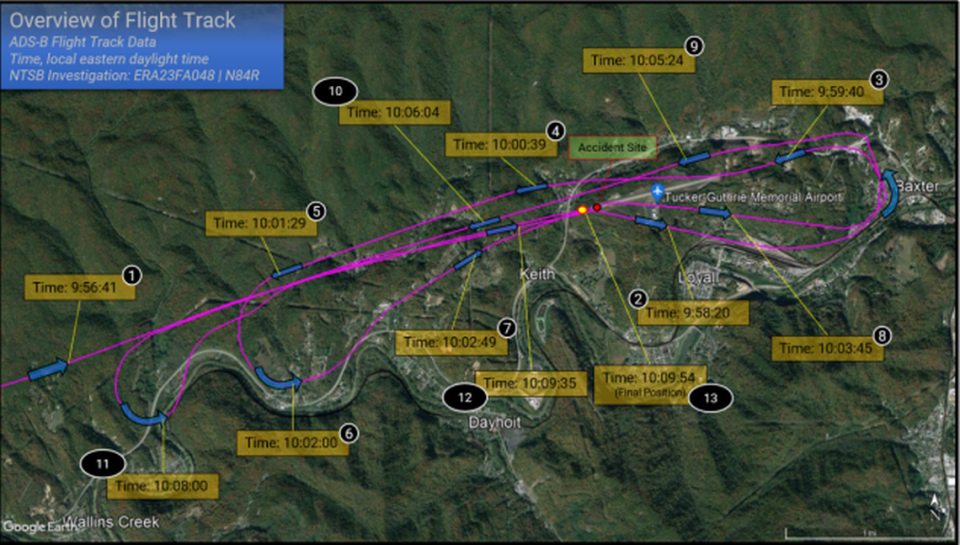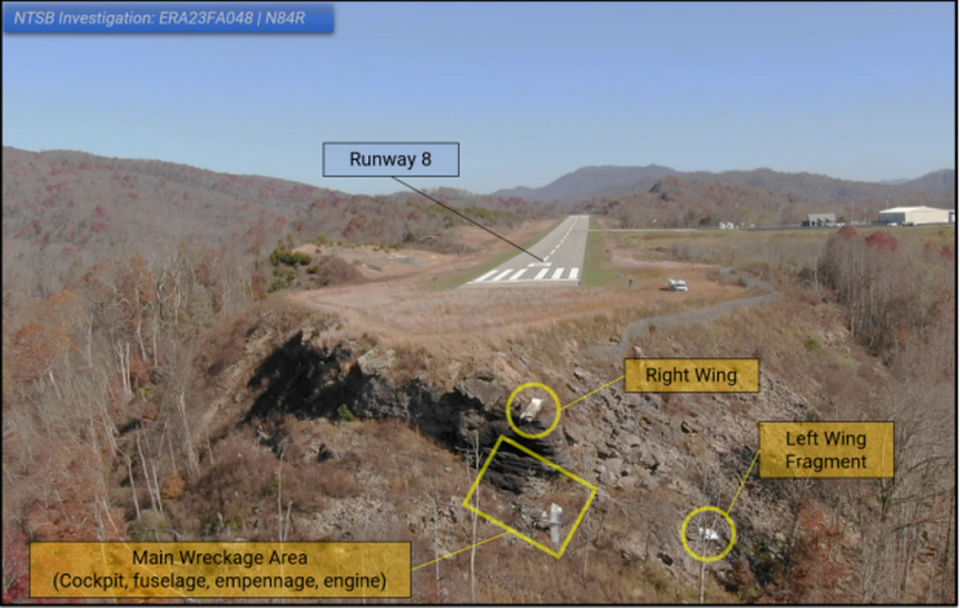Pilot may not have gotten weather briefing before fatal crash at Kentucky airport, report says
A pilot killed in a plane crash while trying to land in heavy fog at an Eastern Kentucky airport may not have gotten a weather briefing before the flight.
There was no record that Dr. David G. Sanford received a weather report, and it is not known what information he received, the National Transportation Safety Board (NTSB) said in a newly-released report.
Sanford, 55, lived in Knoxville, Tennessee, but often flew into Harlan to see patients there.
Sanford, who was by himself, was trying to land at the Tucker-Guthrie Memorial Airport, which is on top of a hill on a spot flattened by coal mining, when he flew in too low and hit a steep rock wall.
The impact site was 50 feet below the level of the runway and 375 feet short of the runway threshold, according to the NTSB report.
The agency released its final report on the Nov. 3, 2022 crash April 25.
Radar information showed Sanford flew two approach paths to the runway but pulled away each time and circled the airport.
Visibility probably was restricted to 200 to 300 feet at the time because of fog and low clouds, the report said.
It is likely Sanford approached at a lower altitude each time while trying to find the runway, the report said.
On the third approach Sanford came in too low and hit the side of the hill.

The investigation showed Sanford regularly flew to the Harlan airport under visual flight rules — under which pilots fly based on what they can see outside the plane — and then did circling maneuvers to land in instrument meteorological conditions.
Instrument meteorological conditions are conditions that require pilots to fly primarily using instruments.
Sanford had logged several hours of instrument flight experience in the three months before the accident, and had flown into the Harlan airport four times in those three months and been able to land after circling under conditions of limited visibility, according to the report.
However, Sanford had not logged enough instrument flight time to “possess instrument currency,” meaning enough time to be considered current on the skill, the report said.
The airport had one published GPS instrument circling approach procedure, but Sanford’s flight path and altitude were not consistent with using that approach, the report said.
The weather conditions at the time were far below the minimum visibility and cloud ceiling for using the published instrument approach for the airport, according to the report.
The NTSB concluded the probable cause of the accident was that Sanford flew from visual flight rule conditions into instrument meteorological conditions while trying to land in mountainous terrain.

The airport had issued a notice a few weeks earlier that the lights identifying the end of the runway were out of service.
However, it’s unlikely the runway lights would have helped Sanford spot the strip because of the extremely low visibility and clouds, the NTSB report concluded.
The agency also said Sanford “demonstrated an anti-authority hazardous attitude, in which he repeatedly disregarded regulations and demonstrated poor judgment.”
That was based on him regularly flying from visual flight rules into instrument meteorological conditions; using an approach that did not match the published instrument approach for the airport; and not being current on instrument flight time, according to the report.
That attitude contributed to the accident, the report said.
The report said it is possible Sanford’s decision to make the flight was influenced by his appointments to see patients in Harlan, increasing the pressure on him to land and get to the office.
The report said weather conditions at the airport cleared up about 90 minutes after the crash.
Sanford grew up in Middlesboro and was a graduate of Middlesboro High School, Lincoln Memorial University and the University of Kentucky College of Medicine, according to his obituary.
He was married and had two children.
After completing an ophthalmology residency at UK, he served patients in southeast Kentucky.
“Dr. Sanford relished both the privilege and opportunity to make a difference in the lives of his patients by helping them to see better,” his obituary said. “He was known not only for his skill as a surgeon but for his humility, kindness, and his terrific sense of humor.”

